As the ski season kicks off, the QC Lab's Black Diamond team is diving deep into the topic of electromagnetic interference and examining how it can impact safety in the backcountry.
The ski season has begun! It's an exciting time of year and many are already waxing their skis, breaking in new boots, trimming skins, practicing searching for buried victims with an avalanche transceiver and brushing up on their knowledge of touring. We shouldn't forget to change the batteries and update the firmware of our all-important avalanche safety electronics.
Why?
Electromagnetic Interference, or EMI for short, are actually present - they can significantly impair the performance of avalanche transceivers and thus endanger off-road safety. Basically, it should be borne in mind that many electronic devices that we take with us into the field can interfere with the search mode of an avalanche transceiver.

In this QC Lab, we examine electromagnetic interference, its impact on backcountry safety, and why firmware updates should be on your preseason checklist.

Electromagnetic Interference (EMI): Unwanted disturbances in an electrical path or circuit caused by an external source that interrupt, impede, or otherwise degrade or limit the effective performance of electronic devices.
For several years now, there has been increasing discussion among experts about electromagnetic interference and its negative effects on the performance of avalanche transceivers. Although this topic is not new, it is becoming increasingly important as the number of winter sports enthusiasts increases and people carry more and more personal electronic devices such as smartphones, smartwatches, GPS devices, heated clothing and electronic airbags.
Understanding
LVS devices are essentially radio devices that operate on an internationally recognized frequency band – 457 kHz. An avalanche transceiver sends a signal pulse every second in transmit mode, which is defined by ETSI EN 300 718-1.
Once the device is placed in search mode, it searches for nearby signal pulses and displays distance and direction information to help locate transceivers (avalanche victims).
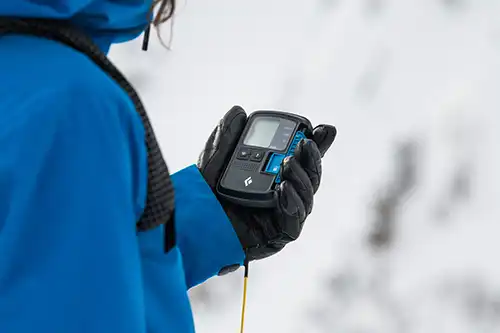
The further you get from a transmitting device, the weaker the signal becomes. At the maximum ranges, an avalanche transceiver attempts to receive a “whisper,” so to speak. And it is in this area that the avalanche transceivers are most susceptible to electromagnetic interference.
There are three major sources of interference that can negatively affect the performance of your transceiver.
1. Passive sources
- Metal objects such as shovels, aluminum foil, foil-reinforced clothing, and magnets.
- Passive sources affect LVS devices in both transmit and search modes.
2. Active sources
- Personal electronic devices such as smartphones, smart watches/rings/bracelets, satellite communication devices, heated gloves, etc.
- Snowmobiles or other motor vehicles
- Active sources have a greater impact on LVS devices in search mode.
3. Environmental sources
- Power lines, iron-bearing rocks, etc.
- Environmental sources also have a greater impact on LVS devices in search mode.
In this QC Lab article, we will discuss the active sources of electromagnetic interference because they pose the greatest danger and can generally be mitigated with some basic knowledge and measures.
Most electronic devices generate electromagnetic interference at different frequencies and in varying degrees. If the interference occurs in the frequency range around 457 kHz, it can affect the performance of transmitting and receiving devices. It is important to remember that consumer electronics are not specifically designed for off-road use and do not take into account the importance of the 457 KHz frequency band.
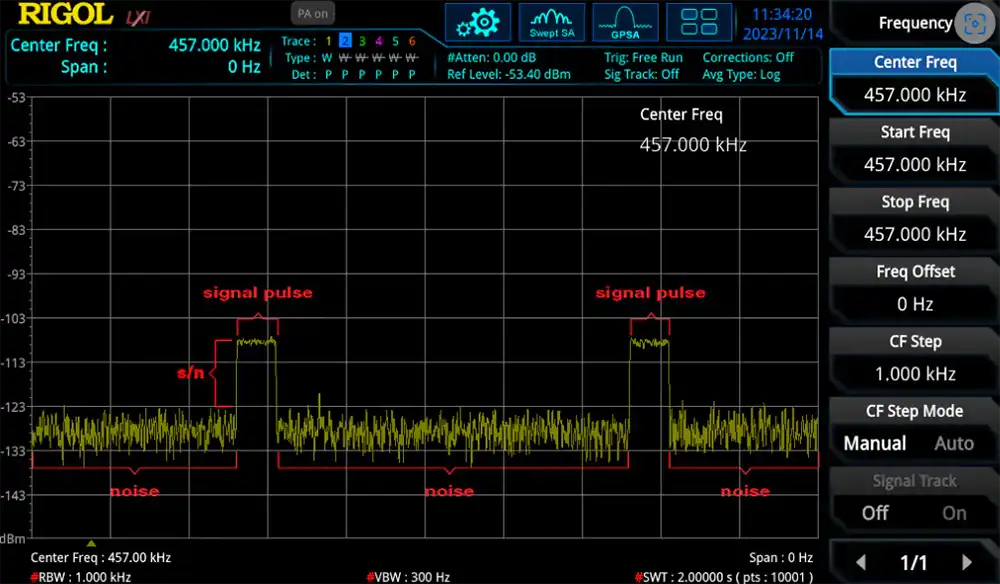
First, let's look at some simple pictures of spectrum analyzers to understand the concepts better. Figure 1 above shows the signal from an avalanche transceiver in a relatively interference-free environment.
Some level of interference is inevitable in the real world. A truly interference-free environment can only be created in the laboratory.
As you can see, the signal level is significantly higher than the interference level. The difference between these levels is called the signal-to-noise ratio (SNR). This ratio is particularly important because the LVS device processor uses this value to distinguish a true LVS signal from all other signals.
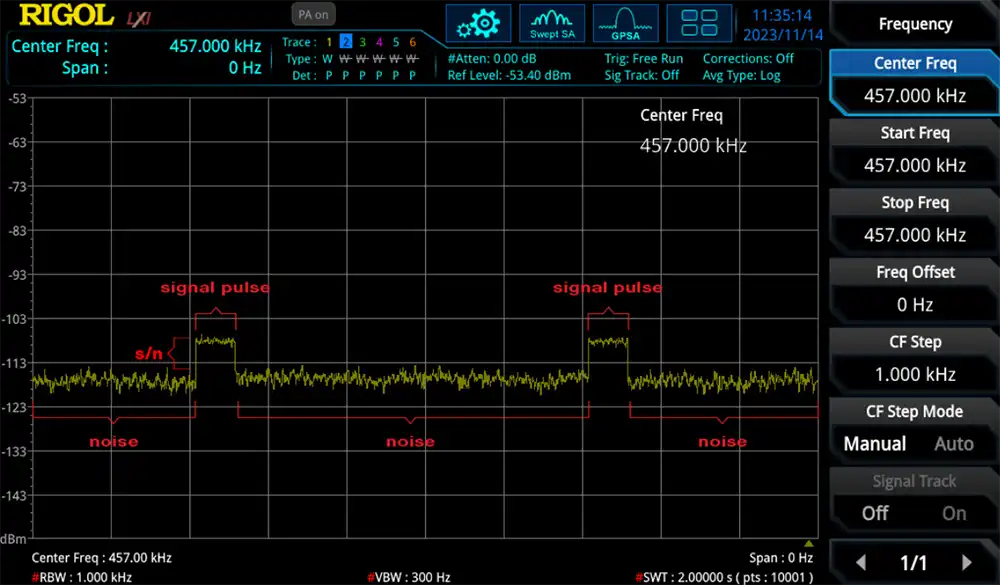
The further you get from the transmitter and the weaker the signal becomes, the more likely the situation will look like Figure 2 above. Note the reduced signal-to-noise ratio.
The images above show the transmit signal from the LVS device in a relatively interference-free environment. If interference from another electronic device is added, the signal-to-noise ratio drops even further. Since interference peaks drown out the desired avalanche signal, the signals can no longer be distinguished. Can you see the difference between the LVS signal and the spikes caused by active interference sources in Figure 3 below?
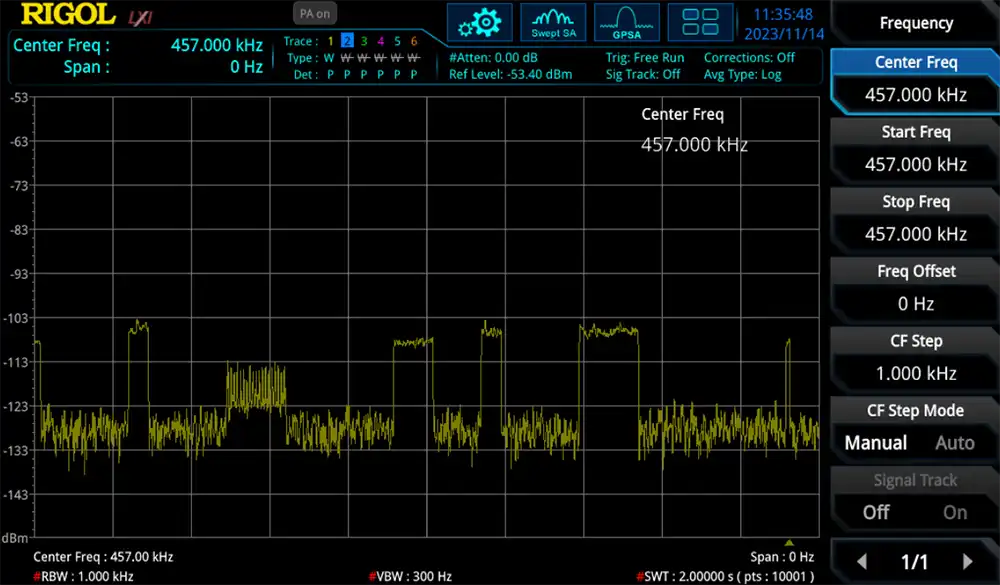
The presence of interference can result in reduced range, reduced direction indicator reliability and so-called “ghost signals”.
Ghost signals occur when glitches resemble a real transmit/receive signal, so the processor interprets them as a transmitting avalanche transceiver. This performance degradation is further exacerbated when the device is at the extreme end of its range.
Why is this relevant?
In short, because it can slow down the search. In avalanche rescue, the signal-to-noise ratio can be very low at the start of the rough search, when an initial signal is to be captured, and any disturbance can have a detrimental effect. Time is of the essence and the clock is ticking!
Ghost signals and inaccurate directional arrows can lead you in the wrong direction, causing you to lose valuable time. Reduced range means you have to reduce the search swath width and get closer to the buried person before you get a reliable signal. In this situation it is particularly important to reduce the number of sources of interference.
What causes interference?
The main cause of electromagnetic interference is other electronic devices in close proximity to the searching transceiver. In this case, distance is the best solution because the electromagnetic interference from an electronic device decreases exponentially the further away it is from your searching avalanche transceiver.
The “20/50 centimeter rule” was developed according to this principle. We can reduce interference by keeping sources of interference at a sufficient distance from the avalanche transceiver.
The 20/50 centimeter rule was introduced industry-wide as a reminder to keep electronic devices and other sources of interference at least 20 cm from a transmitting avalanche transceiver and 50 cm from a searching avalanche transceiver.
It is important to understand that this is a guideline and does not guarantee that it will mitigate all interference. There are many types of electronics on the market, and some cause interference even at distances greater than 50cm. Since it's not possible to test all combinations, we'll focus on the personal electronic devices we most often carry with us in the backcountry.
That's good to know. But how bad is the interference really caused by electronic devices and other items commonly found in the backcountry? In order to better answer this question, Black Diamond's QA team set out to conduct some tests. The focus of these tests was to better understand the degradation of a stable signal (a combination of range and reliability of the directional arrows).
The test setup
The QA crew drove to the Bonneville Salt Flats, west of Salt Lake City, to find a spacious, open space away from any potential electromagnetic interference sources found in the city.
An avalanche transceiver in transmit mode was attached to the end of a 100 m long tape measure. A searching avalanche transceiver was then slowly brought closer until a stable signal for both distance and direction was displayed. The distance at this point was recorded.




QA crew testing at the Bonneville Salt Flats. Images: Christian Adam
Our test used a variety of electronic devices commonly found in the backcountry, including smartwatches, GPS watches, smartphones, two-way radios, action cameras, satellite communications devices, backpacks with electronic airbags, and even a snowmobile.
The searching avalanche transceiver was held at a distance of 50 cm from the upper body using a static holder to maintain the correct distance. Each electronic device was then placed in a normal use position as described below.
The aim was to determine how bad ignoring the 20/50 centimeter rule could be. For this purpose, many electronic devices were kept closer than 50 cm (e.g. heated gloves and smart watches). Each device was tested three times and then the average was recorded. We then calculated the reduction in range compared to a baseline situation in which no other electronic objects were present.
The results
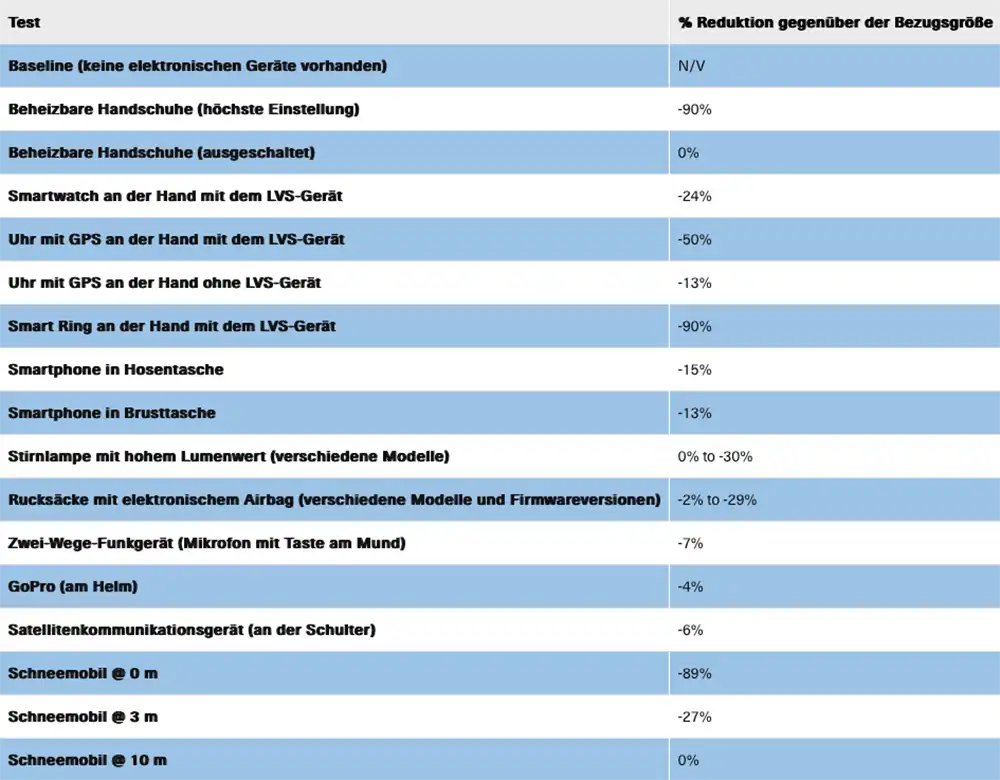
Some notes
- These devices were tested individually. The impact would likely be increased by multiple devices being used at the same time.
- The tests were conducted using a single pair of transceivers and a random selection of electronic devices. They do not represent all devices available on the market. Personal electronic devices will become even more powerful in the next few years.
Our insight is that electromagnetic interference exists and can have a significant impact on the performance of avalanche transceivers. And we can't emphasize enough the importance of updating the firmware of avalanche transceivers and electronic avalanche airbags.
firmware
Manufacturers of transceivers and electronic airbag backpacks are constantly evolving their firmware to improve their performance (much like the apps on your phone are constantly updated). Firmware updates can improve functionality, extend battery life, reduce the generation of harmful interference, and improve noise processing.
Therefore, it is extremely important to keep the firmware for these products up to date. But we know that many people don't do that. Please do better. Update your firmware today. It's simple and can often easily be done via an app on your phone. Information about performing firmware updates can be found on the manufacturer's website.
Conclusions, key findings and general guidelines
- Think about electromagnetic interference.
· They exist and can significantly affect the performance of your transceiver.
· They have the greatest impact during the initial signal acquisition, when you want to waste the least amount of time.
· The closer you get to the transmitting device and the stronger its signal becomes, the less interference will have.
· You probably don't realize or realize that your avalanche transceiver is affected by interference, especially during an avalanche event that involves high levels of stress.
· The more powerful and the closer electronics are to the avalanche transceiver, the more likely they are to cause significant interference. - Is electromagnetic interference the most important factor affecting your safety in the backcountry?
· No. Avoiding avalanche-prone terrain, receiving appropriate training and carrying an avalanche transceiver, shovel and probe are at the top of the list. However, dealing with electromagnetic interference is part of comprehensive off-road safety management. In some cases, not taking this aspect into account can make a big difference and significantly slow down the transceiver search. - Some level of interference is inevitable, but can be kept to a minimum by being aware of what electronic devices are being used and where they are being carried. It is advisable to discuss this with the group at the starting point of the tour before setting off.
- Always keep the firmware of your avalanche transceiver and electronic avalanche equipment up to date.
- Some modern transceivers can detect the presence of interference and indicate on the display that the search strip width should be reduced.
- As with many safety and risk decisions in the mountains, it is your responsibility to know your equipment and your group's risk tolerance.
· If you want as little disruption as possible, turn off and/or move away from all unnecessary electronic devices.
· Otherwise, you should follow the 20/50 centimeter rule as well as some generally accepted guidelines shown in the graphics below.
That might interest you
- This is what you need to know about avalanche airbags
- Will there be more wet snow avalanches in the future?
- You need to know these three components of avalanche equipment
Do you like our climbing magazine? When launching the climbing magazine Lacrux, we decided not to introduce a paywall because we want to provide as many like-minded people as possible with news from the climbing scene.
In order to be more independent of advertising revenue in the future and to provide you with even more and better content, we need your support.
Therefore: Help and support our magazine with a small contribution. Naturally you benefit multiple times. How? You will find out here.
+ + +
Credits: Cover image Andy Earl, text Black Diamond

